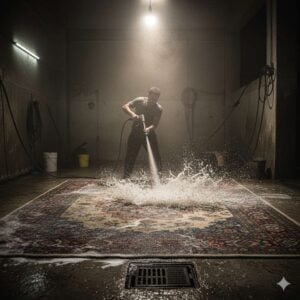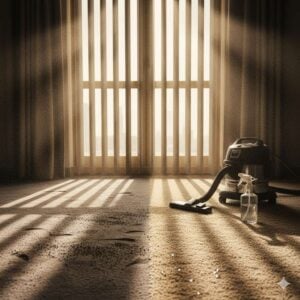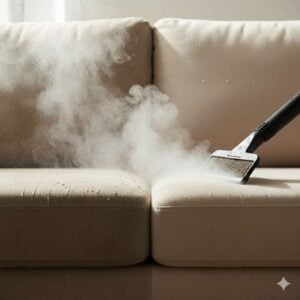Hello and welcome to our latest exploration into the essential realm of home safety and recovery. Today, we’re delving into fire damage and restoration, a critical topic for any homeowner facing the aftermath of a fire. Understanding the steps to mitigate fire damage and restore your home is not just about repair; it’s about reclaiming your peace of mind and ensuring a safe, healthy environment for you and your loved ones. Fire incidents can strike unexpectedly, leaving a trail of destruction in their wake. However, with the right knowledge and actions, the journey from damage to restoration can be navigated effectively. Join us as we share valuable insights and steps to help you through this challenging time.
Table of Contents
Toggle#1 Initial Assessment and Safety
Once the immediate threat of fire has passed, the paramount concern shifts to ensuring the safety of the site before any cleanup or restoration efforts can begin. This involves a detailed assessment to evaluate structural damages and identify any hazards that could pose risks during the restoration process. The safety assessment is twofold: first, professionals inspect the integrity of the building’s structure—walls, floors, and ceilings must be checked for stability. Any sign of weakness could indicate a risk of collapse, making it imperative to address these issues before proceeding.
Second, the assessment covers potential hazards such as exposed electrical wiring, gas leaks, and chemical exposures. These dangers can lurk unseen and present significant risks to homeowners and restoration crews alike. It’s also crucial to ensure the property is environmentally safe for workers, which may involve testing for toxic substances like asbestos or lead, common in older homes and potentially disturbed during a fire.
The initial safety check is a critical step that dictates the pace and direction of the entire restoration journey. It’s about making informed decisions that prioritize the well-being of everyone involved, laying a safe foundation for the hard work of rebuilding and restoration that lies ahead.
#2 Documentation and Insurance
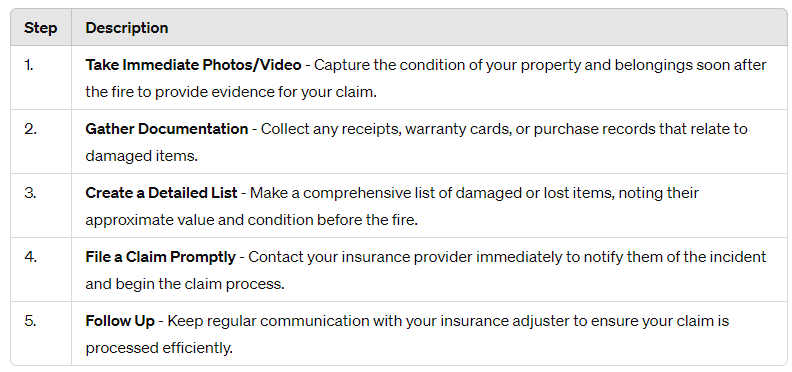
In the aftermath of a fire, documentation becomes a critical step in the recovery process. It is essential for insurance claims and for planning the restoration work. Start by safely documenting all damages as soon as possible after the event. This involves taking comprehensive photographs and videos of the affected areas, capturing both the extent of the damage and specific items that were lost or damaged. It’s important to be thorough, as these records will be vital when filing an insurance claim.
Navigating the insurance process smoothly requires organization and attention to detail. Homeowners should carefully review their insurance policy to understand what is covered and the procedure for filing a claim. Early communication with the insurance company is crucial; informing them about the fire and the intent to file a claim should be done promptly. As part of the claim process, insurers may require a detailed list of damaged or lost items, including their value and any proof of purchase if available.
This step can be complex and emotionally challenging, as it involves revisiting the loss repeatedly. However, accurate and detailed documentation is key to ensuring a fair and efficient claims process. It also helps in planning the restoration work, providing a clear picture of what needs to be done to restore the property.
#3 Salvaging What You Can
After ensuring safety and documenting damage, the focus shifts to salvaging whatever items are recoverable. This step is crucial not only for preserving personal belongings but also for minimizing the overall impact and cost of the disaster. The process begins by carefully evaluating each item to determine if it can be cleaned, restored, or if it must be discarded. Items that often can be salvaged include clothing, some furnishings, and certain personal items, provided they have not been too severely damaged by fire, water, or smoke.
The key to effective salvage is prompt and appropriate action. Non-porous items like glass, metal, and hard plastic can often be cleaned and disinfected. However, porous materials such as fabric, paper, and untreated wood may require professional assessment to determine if restoration is possible. Specialized cleaning methods can sometimes remove soot and smoke odors, but it’s important to recognize when items are beyond saving.
Sorting items into categories based on their condition and the feasibility of restoration helps streamline the process. This organized approach allows homeowners to focus their efforts and resources on items with the best chances of being saved. It also aids in making informed decisions about what to replace, which is essential for the insurance claims process and for personal closure.
#4 Smoke and Soot Removal
Smoke and soot can penetrate various surfaces and materials, causing significant damage even after the flames are extinguished. The removal of these residues is a critical step in the restoration process, not only for the sake of cleanliness but also to prevent long-term damage and health issues. Soot, a byproduct of incomplete combustion, contains acidic substances that can corrode metals, deteriorate fabrics, and stain walls. Smoke, on the other hand, can leave a pervasive odor and deposit harmful chemicals.
The first step in tackling smoke and soot is to ventilate the area thoroughly, as this helps reduce the immediate presence of these substances. It’s then important to use the correct cleaning methods and products for different materials. For hard surfaces, specialized soot sponges and chemical cleaners designed for soot removal can be effective. However, care must be taken to avoid embedding the soot deeper into surfaces.
Textiles and upholstered items require a different approach, often involving dry cleaning or specialized laundering to remove soot and odors without causing further damage. It’s crucial to address these items quickly, as soot and smoke can become more difficult to remove over time.
Professional services are sometimes necessary for thorough cleaning, especially for HVAC systems and interiors where smoke can circulate and settle. These professionals have the equipment and expertise to effectively remove soot and smoke residues, ensuring the home is not only clean but safe for its occupants.
#5 Dealing with Water Damage
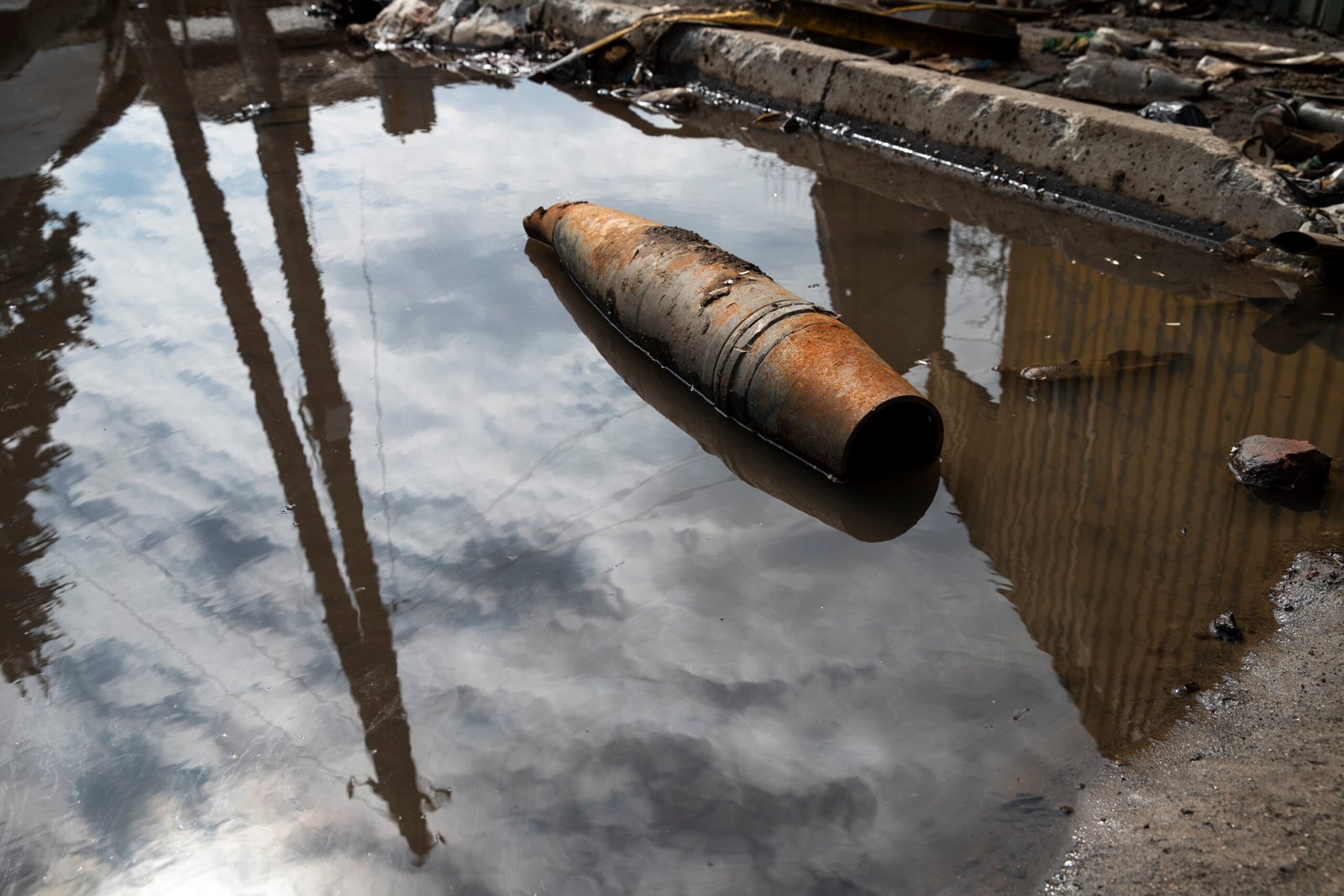
Water damage resulting from firefighting efforts is a common yet often overlooked aspect of fire damage restoration. Extinguishing a fire typically requires large volumes of water, which can soak into structures, furnishings, and belongings, leading to further damage long after the fire is out. The immediate goal is to dry out the affected areas to prevent the growth of mold, which can start to develop within 24 to 48 hours in moist conditions.
The process begins with removing standing water using pumps or vacuums. This step should be undertaken carefully to avoid exacerbating structural damages. After removing the water, circulating air with fans and dehumidifiers helps to speed up the drying of walls, floors, and other surfaces. It’s crucial to monitor the moisture levels in the air and materials using moisture meters to ensure that the environment is drying effectively.
Special attention should be given to carpets, upholstery, and drywall, which can absorb water and require removal or specialized drying techniques. Salvageable items should be dried and cleaned promptly to prevent mold and mildew buildup.
In cases of significant water damage, professional restoration services may be necessary. These experts have the tools and knowledge to handle severe situations, including mold remediation, which is essential for maintaining indoor air quality and preventing health issues.
#6 Odor Elimination
Eliminating the persistent odors left by smoke and fire is a critical step in the restoration process, essential for making a home livable again. Smoke particles can embed themselves deep within materials and structures, releasing odors over time and making complete odor removal challenging. The key to effective odor elimination lies in a combination of techniques aimed at both the air and the affected materials.
Air purification plays a pivotal role in this process. Using air scrubbers and ozone generators can help remove smoke particles from the air. Air scrubbers work by pulling air through filters, trapping particles, while ozone generators produce ozone gas that oxidizes and neutralizes smoke odor molecules. However, ozone generators should be used with caution and only in unoccupied spaces due to the potential health risks ozone gas can pose.
For materials, thorough cleaning is essential. This includes laundering or dry cleaning fabrics and deep cleaning upholstered furniture, carpets, and curtains. Hard surfaces like walls, floors, and ceilings may require washing with specialized cleaning solutions designed to break down smoke residues and neutralize odors. In some cases, materials that cannot be cleaned or are too heavily damaged may need to be replaced to completely remove odors.
Professional odor removal services often employ a combination of these techniques, tailoring their approach based on the severity of the odor and the types of materials affected. They have the expertise and equipment necessary to ensure that odors are not just masked but truly eliminated.
#7 Deep Cleaning and Sanitization
Following a fire, deep cleaning and sanitization are indispensable to restore a home to a safe and healthy living condition. This comprehensive cleaning goes beyond the surface, addressing hidden soot, ash, and potential contaminants that can affect air quality and pose health risks. The process involves several critical steps, each tailored to different parts of the home and types of materials affected by the fire and firefighting efforts.
For hard surfaces, such as countertops, floors, and walls, deep cleaning involves using specialized cleaning agents that can remove soot and disinfect the area. These agents are designed to handle the tough residues left by fire and smoke without damaging the surfaces. Soft furnishings, including carpets, curtains, and upholstered items, require professional cleaning techniques such as steam cleaning or hot water extraction. These methods not only remove dirt and soot but also kill bacteria and remove odors, restoring these items to their pre-fire condition as much as possible.
Air ducts and HVAC systems also need attention, as they can harbor soot, smoke particles, and odors that can circulate throughout the house. Professional cleaning of these systems is crucial to prevent the spread of contaminated air, ensuring that the home’s air is clean and safe to breathe.
Sanitization is the final layer of protection, eliminating any remaining bacteria or viruses that could pose health risks. This step ensures that the environment is not only visually clean but also hygienically safe for the occupants.
#8 Restoration and Reconstruction
The restoration and reconstruction phase is a beacon of hope for homeowners, marking the beginning of turning a damaged structure back into a home. This stage involves repairing or rebuilding parts of the property that were damaged or destroyed by the fire. The process starts with a detailed assessment by professionals to determine the extent of the structural damage and to develop a plan for the necessary repairs or reconstruction.
One of the first steps in restoration is to secure the property and prevent further damage. This might involve boarding up windows and doors or placing tarps over damaged roofs. Then, the focus shifts to the structural repairs, which may include fixing or replacing damaged walls, floors, and roofs. Attention to detail is crucial during this phase to ensure the home is safe and structurally sound.
Choosing materials and design for reconstruction offers homeowners an opportunity to not only restore their property but also to improve it. This could be an ideal time to consider upgrades or changes that could enhance the home’s functionality, efficiency, or aesthetic appeal. Whether it’s installing more durable materials, upgrading to energy-efficient windows, or redesigning the layout to better suit the family’s needs, reconstruction can be tailored to the homeowner’s preferences and requirements.
Collaboration with architects, contractors, and designers is key to ensure that the rebuilding process aligns with the homeowner’s vision and budget. The goal is to restore the property to its former condition or better, turning the aftermath of a disaster into an opportunity for improvement and renewal.
#9 Emotional and Mental Recovery
The journey of recovery from a fire does not end with the physical restoration of the property. Emotional and mental recovery is an integral part of overcoming the trauma associated with such a devastating event. Acknowledging and addressing the psychological impact is crucial for the well-being of all affected individuals. The process can be complex and varies greatly from person to person, involving a range of emotions including shock, grief, anger, and frustration.
One of the first steps toward emotional healing is seeking support. This can come from family, friends, community support groups, or professional counselors specialized in trauma. Sharing experiences and feelings with others who understand or have gone through similar situations can provide comfort and a sense of belonging.
Creating a routine or returning to a pre-disaster routine can also play a significant role in mental recovery. It helps in establishing a sense of normalcy and control over one’s life. Engaging in regular activities such as work, school, hobbies, or social events can contribute to the overall healing process.
Additionally, finding ways to contribute positively to the recovery of others or the community can be therapeutic. Volunteering or supporting fire prevention causes can empower individuals and help them find meaning after the loss.
It’s important for individuals to give themselves time and permission to grieve and heal at their own pace. Recognizing that recovery is a personal journey and that it’s okay to seek help is essential in moving forward after a fire.
#10 Preventive Measures for the Future

After navigating the challenging process of restoration and recovery from fire damage, implementing preventive measures becomes a crucial next step. This is not just about repairing the past but safeguarding the future. A comprehensive approach to fire prevention involves both installing safety devices and adopting practices that reduce the risk of fire.
Installing smoke alarms in key areas throughout the home is the first line of defense against future fires. Smoke alarms should be tested regularly, and batteries replaced as needed to ensure they are always in working order. Similarly, installing a home sprinkler system can significantly reduce the damage caused by fires, often extinguishing flames before they can spread extensively.
Equally important is the practice of safe electrical habits. This includes not overloading electrical outlets, regularly inspecting cords for wear and tear, and using appliances responsibly. Educating all household members about the dangers of fire and how to avoid them is vital. Simple actions like never leaving cooking unattended and storing flammable materials properly can have a significant impact on fire prevention.
Fire escape planning is another critical preventive measure. Every household should have a clear and practiced fire escape plan, ensuring that all members know how to exit the home quickly and safely in the event of a fire.
Finally, consider the installation of fire-resistant materials during any home repairs or renovations. These materials can slow the spread of fire, giving residents more time to escape and reducing damage.
Why Bio On is Your Go-to Solution for Fire Damage and Restoration
Bio On stands as your definitive solution for fire damage and restoration, embodying expertise and commitment in every service offered. With a deep understanding of the complexities involved in fire recovery, Bio On provides comprehensive services ranging from initial damage assessment to the final steps of restoration. Utilizing state-of-the-art techniques and equipment, the focus is on quality and efficiency, ensuring that each restoration project is approached with the utmost care and professionalism.
Bio On also prioritizes safety and health, employing specialized methods for smoke, soot, and odor elimination to restore not just the physical structure of your home but also the air quality within it. This holistic approach to fire damage recovery, combined with around-the-clock consultation availability, makes Bio On the go-to partner in navigating the aftermath of a fire, guaranteeing peace of mind and a return to normalcy with precision and empathy.
Conclusion
In conclusion, navigating the aftermath of a fire encompasses a series of critical steps, from initial damage assessment to deep cleaning, restoration, and implementing future preventive measures. Each step is essential in the journey towards recovery, aiming to restore safety, comfort, and peace of mind. Understanding the emotional and mental recovery process is equally important, acknowledging the comprehensive impact of such events. Bio On offers unparalleled expertise and support throughout this journey, providing a seamless, empathetic approach to fire damage recovery. For personalized guidance and a free consultation, reach out to the Bio On team through the Whatsapp button. Your path to restoration begins with a single click, ensuring expert assistance every step of the way.









